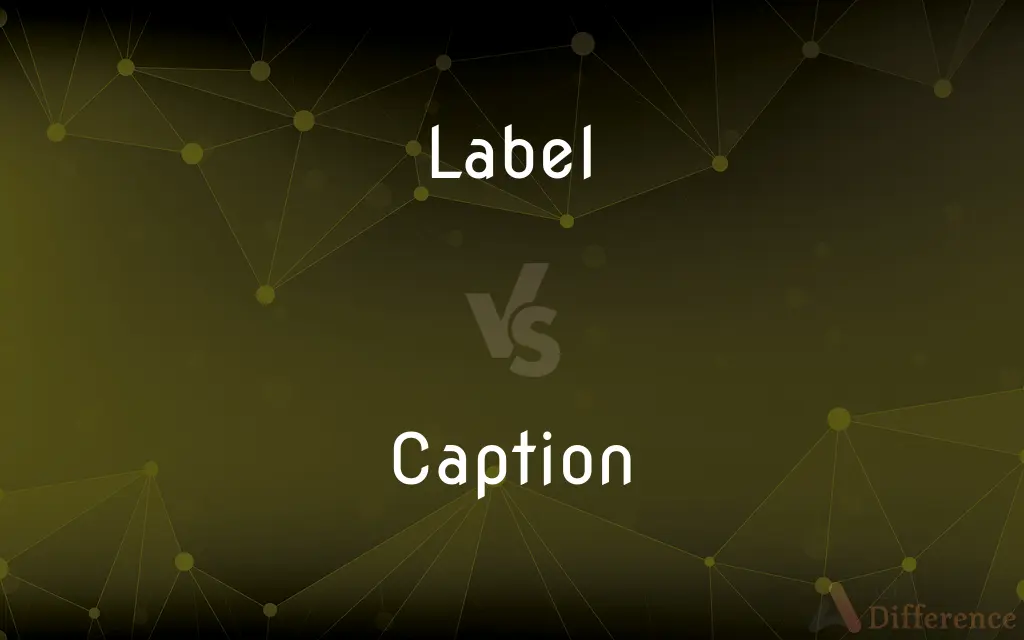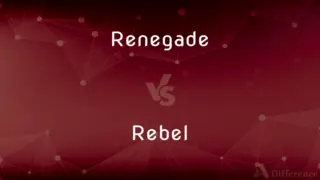Label vs. Caption — What's the Difference?
By Tayyaba Rehman & Fiza Rafique — Updated on March 24, 2024
Label refers to a tag or marker identifying an object or item, while a caption adds context or explanation to a visual element.

Difference Between Label and Caption
Table of Contents
ADVERTISEMENT
Key Differences
Label is typically used to provide identification or basic information about an object or product, such as its name, content, or usage instructions, whereas caption is used to offer descriptive information or commentary about an image, diagram, or other visual elements in a text.
Labels are often found on items like clothing, food products, and appliances, providing essential details like brand, size, ingredients, or operational guidelines. Captions, on the other hand, are commonly used in books, articles, and online content, accompanying photographs, illustrations, and figures to enhance understanding or convey a specific message.
While labels serve a practical purpose in organizing and providing factual details about objects, captions aim to add narrative, context, or interpretive information to visual content, enriching the viewer's or reader's experience.
Labels are typically concise and to the point, focusing on necessary information that aids in identification or usage. Captions, however, can be more varied in length and style, ranging from brief explanations to more elaborate descriptions or commentary, depending on the intended message or the complexity of the visual content.
Labels often utilize a standardized format or set of guidelines, especially in commercial or industrial contexts, to ensure consistency and compliance with regulations. Captions, while they can follow certain stylistic conventions, offer more flexibility in terms of language, tone, and format, allowing for creativity and personalization in how information is conveyed.
ADVERTISEMENT
Comparison Chart
Purpose
To identify and provide basic information about an object or product.
To provide descriptive or explanatory text for visual content.
Placement
Attached to or printed directly on the object or product.
Below or adjacent to images, diagrams, or figures in texts.
Content Type
Factual details like name, ingredients, usage instructions.
Descriptive or interpretive information related to visual content.
Length
Generally concise and to the point.
Can vary from brief to elaborate, depending on context.
Tone
Often informative and straightforward.
Can range from informative to narrative, depending on the content.
Compare with Definitions
Label
A piece of paper, cloth, or other material attached to an object to identify or describe it.
The label on the bottle listed all the ingredients.
Caption
Text that explains or describes an image or photograph.
The caption under the photo explained the historical context.
Label
A piece of paper on a package or envelope indicating the address.
Please ensure the label on the parcel is clear and accurate.
Caption
A title or heading used for a photograph in publications.
The caption for the award-winning image was poignant.
Label
A term or phrase used to classify or categorize something.
The library uses color-coded labels for different genres.
Caption
A brief explanation or comment accompanying an illustration.
Each cartoon in the book had a witty caption.
Label
A brand name or logo displayed on a product.
Designer labels are often a status symbol in fashion.
Caption
Text associated with a figure or diagram to provide explanation.
The diagram was complex but made clear with detailed captions.
Label
Information provided on a product about its use or care.
The label on the medication specifies the dosage instructions.
Caption
Text displayed on a video screen to provide additional information.
Captions in the documentary included translations of foreign dialogue.
Label
A label (as distinct from signage) is a piece of paper, plastic film, cloth, metal, or other material affixed to a container or product, on which is written or printed information or symbols about the product or item. Information printed directly on a container or article can also be considered labelling.
Caption
A title, short explanation, or description accompanying an illustration or a photograph.
Label
An item used to identify something or someone, as a small piece of paper or cloth attached to an article to designate its origin, owner, contents, use, or destination.
Caption
A series of words superimposed on the bottom of television or motion picture frames that communicate dialogue to the hearing-impaired or translate foreign dialogue.
Label
A descriptive term; an epithet.
Caption
A title or heading, as of a document or article.
Label
A distinctive name or trademark identifying a product or manufacturer, especially a recording company.
Caption
(Law) The heading of a pleading or other document that identifies the parties, court, term, and number of the action.
Label
(Architecture) A molding over a door or window; a dripstone.
Caption
To furnish a caption for.
Label
(Heraldry) A figure in a field consisting of a narrow horizontal bar with several pendants.
Caption
(typography) The descriptive heading or title, of a document or part thereof.
Label
(Chemistry) See tracer.
Caption
A title or brief explanation attached to an illustration, cartoon, user interface element, etc.
Label
To attach a label to
Labeled the jars before storing them.
Caption
A piece of text appearing on screen as a subtitle or other part of a film or broadcast, describing dialogue (and sometimes other sound) for viewers who cannot hear.
Label
To identify or designate with a descriptive term; describe or classify
"He missed two crucial penalty kicks ... and was labeled a loser by the previously loyal British press" (Phil Ball).
Caption
(legal) The section on an official paper (for example, as part of a seizure or capture) that describes when, where, and what was taken, found or executed, and who authorized the act.
Label
(Chemistry) To add a tracer to (a compound).
Caption
A seizure or capture, especially of tangible property (chattel).
Label
A small ticket or sign giving information about something to which it is attached or intended to be attached.
We laughed at her because the label was still on her new sweater.
The label says this silk scarf should not be washed in the washing machine.
Although the label priced this poster at three pounds, I got it for two.
Caption
To add captions to a text or illustration.
Only once the drawing is done will the letterer caption it.
Label
A name given to something or someone to categorise them as part of a particular social group.
Ever since he started going to the rock club, he's been given the label "waster".
Caption
To add captions to a film or broadcast.
Label
(music) A company that sells records.
The label signed the band after hearing a demo tape.
Caption
A caviling; a sophism.
This doctrine is for caption and contradiction.
Label
(computing) A user-defined alias for a numerical designation, the reverse of an enumeration.
Storage devices can be given by label or ID.
Caption
The act of taking or arresting a person by judicial process.
Label
(computing) A named place in source code that can be jumped to using a GOTO or equivalent construct.
Caption
That part of a legal instrument, as a commission, indictment, etc., which shows where, when, and by what authority, it was taken, found, or executed.
Label
(heraldry) A charge resembling the strap crossing the horse’s chest from which pendants are hung.
Caption
The heading of a chapter, section, or page.
Label
(obsolete) A tassel.
Caption
Taking exception; especially an quibble based on a captious argument;
A mere caption unworthy of a reply
Label
A small strip, especially of paper or parchment (or of some material attached to parchment to carry the seal), but also of iron, brass, land, etc.
Caption
Translation of foreign dialogue of a movie or TV program; usually displayed at the bottom of the screen
Label
A piece of writing added to something, such as a codicil appended to a will.
Caption
Brief description accompanying an illustration
Label
(historical) A brass rule with sights, formerly used with a circumferentor to take altitudes.
Caption
Provide with a caption, as of a photograph or a drawing
Label
(architecture) The projecting moulding by the sides, and over the tops, of openings in mediaeval architecture.
Label
In mediaeval and later art, a representation of a band or scroll containing an inscription.
Label
(graphical user interface) A non-interactive control or widget displaying text, often used to describe the purpose of another control.
Label
(transitive) To put a label (a ticket or sign) on (something).
The shop assistant labeled all the products in the shop.
Label
(ditransitive) To give a label to (someone or something) in order to categorise that person or thing.
He's been unfairly labeled as a cheat, although he's only ever cheated once.
Label
(biochemistry) To replace specific atoms by their isotope in order to track the presence or movement of this isotope through a reaction, metabolic pathway or cell.
Label
(biochemistry) To add a detectable substance, either transiently or permanently, to a biological substance in order to track the presence of the label-substance combination either in situ or in vitro
Label
A tassel.
Label
A slip of silk, paper, parchment, etc., affixed to anything, and indicating, usually by an inscription, the contents, ownership, destination, etc.; as, the label of a bottle or a package.
Label
A slip of ribbon, parchment, etc., attached to a document to hold the appended seal; also, the seal.
Label
A writing annexed by way of addition, as a codicil added to a will.
Label
A barrulet, or, rarely, a bendlet, with pendants, or points, usually three, especially used as a mark of cadency to distinguish an eldest or only son while his father is still living.
Label
A brass rule with sights, formerly used, in connection with a circumferentor, to take altitudes.
Label
The name now generally given to the projecting molding by the sides, and over the tops, of openings in mediæval architecture. It always has a square form, as in the illustration.
Label
In mediæval art, the representation of a band or scroll containing an inscription.
Label
To affix a label to; to mark with a name, etc.; as, to label a bottle or a package.
Label
To affix in or on a label.
Label
A brief description given for purposes of identification;
The label Modern is applied to many different kinds of architecture
Label
Trade name of a company that produces musical recordings;
The artists and repertoire department of a recording label is responsible for finding new talent
Label
A radioactive isotope that is used in a compound in order to trace the mechanism of a chemical reaction
Label
An identifying or descriptive marker that is attached to an object
Label
Assign a label to; designate with a label;
These students were labelled `learning disabled'
Label
Attach a tag or label to;
Label these bottles
Label
Pronounce judgment on;
They labeled him unfit to work here
Label
Distinguish (as a compound or molecule) by introducing a labeled atom
Label
Distinguish (an element or atom) by using a radioactive isotope or an isotope of unusual mass for tracing through chemical reactions
Common Curiosities
Are labels always physical tags or stickers?
Not necessarily. Labels can also be digital or printed directly onto the surface of a product or object.
How does a caption enhance a visual element?
By providing context, narrative, or explanatory information, making the visual element more meaningful or understandable.
Can labels include branding information?
Yes, labels often include brand names, logos, and other branding elements to signify the product's origin or manufacturer.
How important is the tone in captions?
The tone in captions can significantly affect how the accompanying visual content is perceived, ranging from serious to humorous.
Can captions be used for educational purposes?
Absolutely. Captions are often used in educational materials to explain or elaborate on visual content, aiding in learning.
What makes a good caption in journalism or media?
A good caption provides clear and concise information, adds context, and engages the reader without overshadowing the visual content.
How do captions contribute to accessibility in media?
Captions, especially in videos, enhance accessibility by providing text alternatives for audio content, benefiting those who are deaf or hard of hearing.
In what contexts are captions most commonly used?
Captions are widely used in publications, online content, and visual media to accompany images, diagrams, and videos.
What is the primary function of a label?
To identify, categorize, or provide essential information about an object or product.
Do captions always have to be directly below an image?
While traditionally placed below images, captions can also appear above, beside, or even within images, depending on design preferences.
Can labels provide usage instructions?
Yes, many labels, especially on products like medications or appliances, provide instructions for safe and effective use.
Is there a standard format for labels and captions?
While there are general conventions, the format can vary depending on the context, purpose, and medium, with flexibility for creative expression.
Are there regulations governing the content of labels?
Yes, in many industries, especially food, pharmaceuticals, and cosmetics, labels must comply with regulatory standards for content and format.
Is it possible for a label to serve as a marketing tool?
Definitely. Labels can be designed to attract attention and convey brand values, serving as an effective marketing tool.
Can a label affect the consumer's perception of a product?
Yes, the design, information, and overall presentation of a label can significantly influence consumer perceptions and choices.
Share Your Discovery

Previous Comparison
Loris vs. Lemur
Next Comparison
Renegade vs. RebelAuthor Spotlight
Written by
Tayyaba RehmanTayyaba Rehman is a distinguished writer, currently serving as a primary contributor to askdifference.com. As a researcher in semantics and etymology, Tayyaba's passion for the complexity of languages and their distinctions has found a perfect home on the platform. Tayyaba delves into the intricacies of language, distinguishing between commonly confused words and phrases, thereby providing clarity for readers worldwide.
Co-written by
Fiza RafiqueFiza Rafique is a skilled content writer at AskDifference.com, where she meticulously refines and enhances written pieces. Drawing from her vast editorial expertise, Fiza ensures clarity, accuracy, and precision in every article. Passionate about language, she continually seeks to elevate the quality of content for readers worldwide.














































